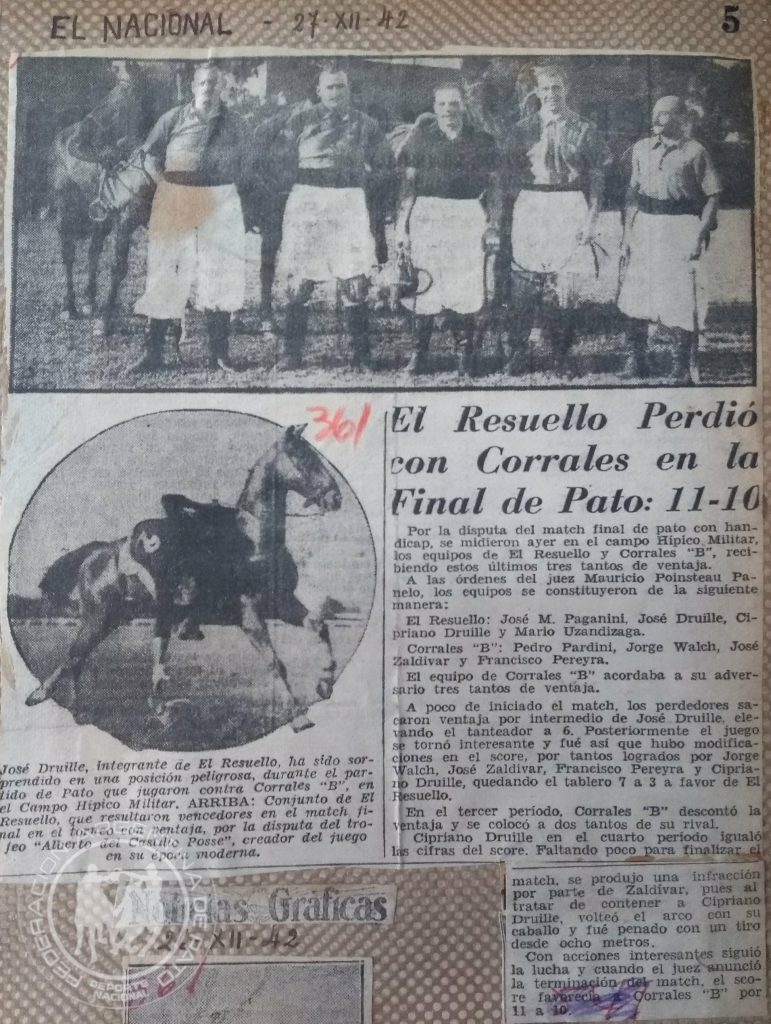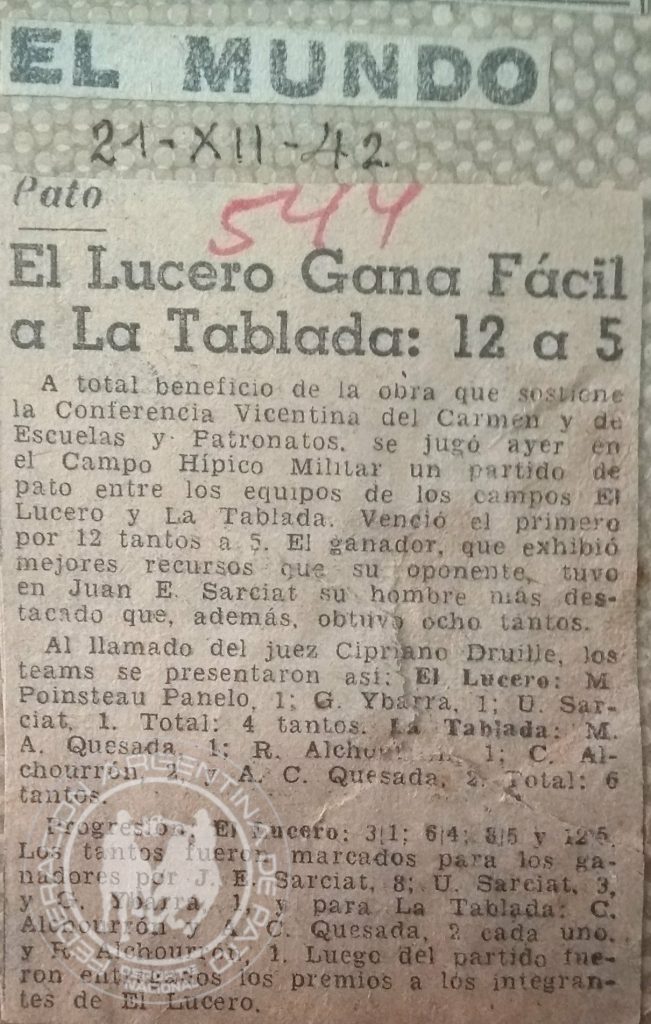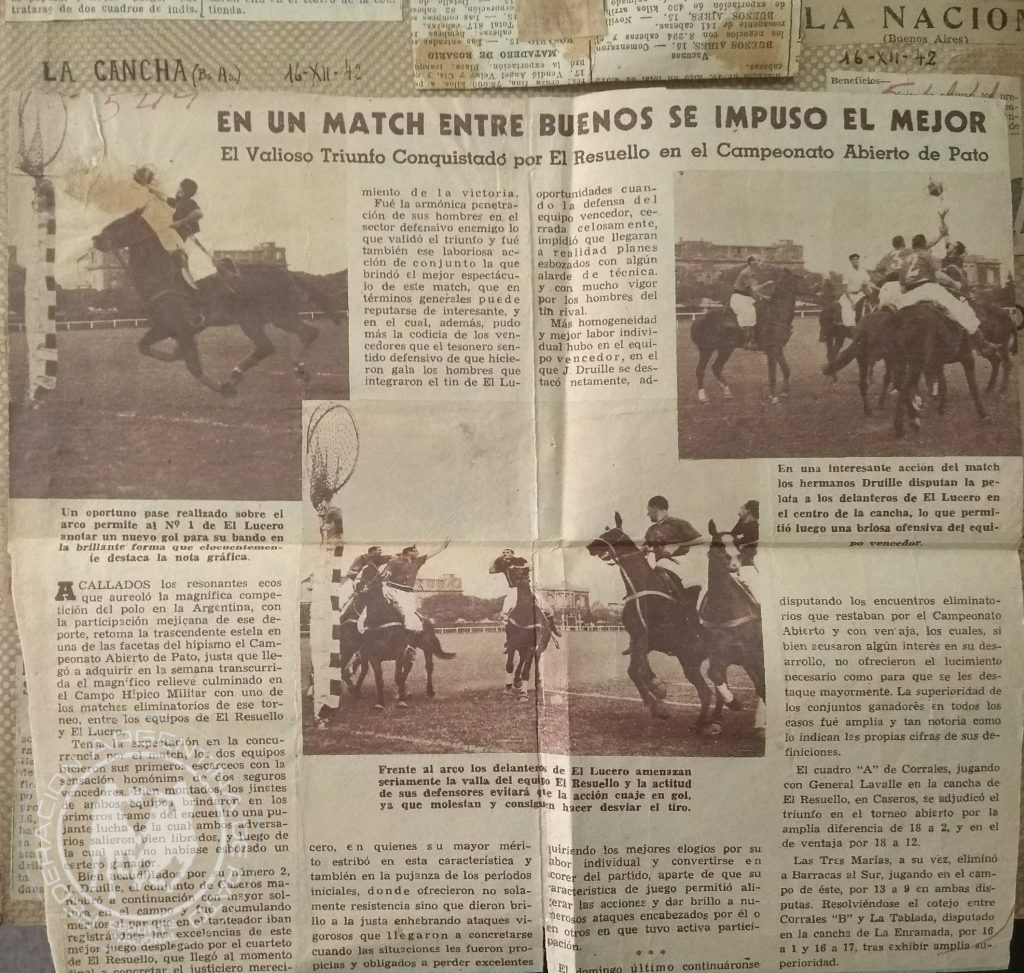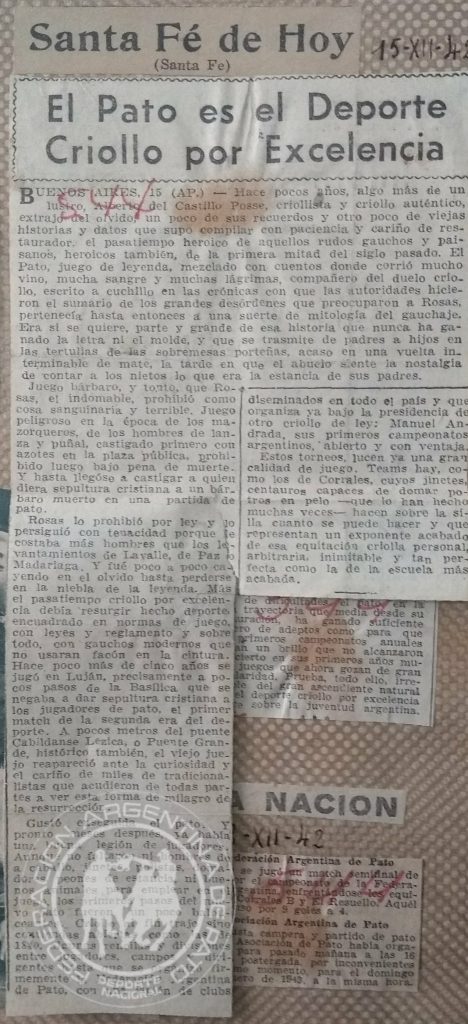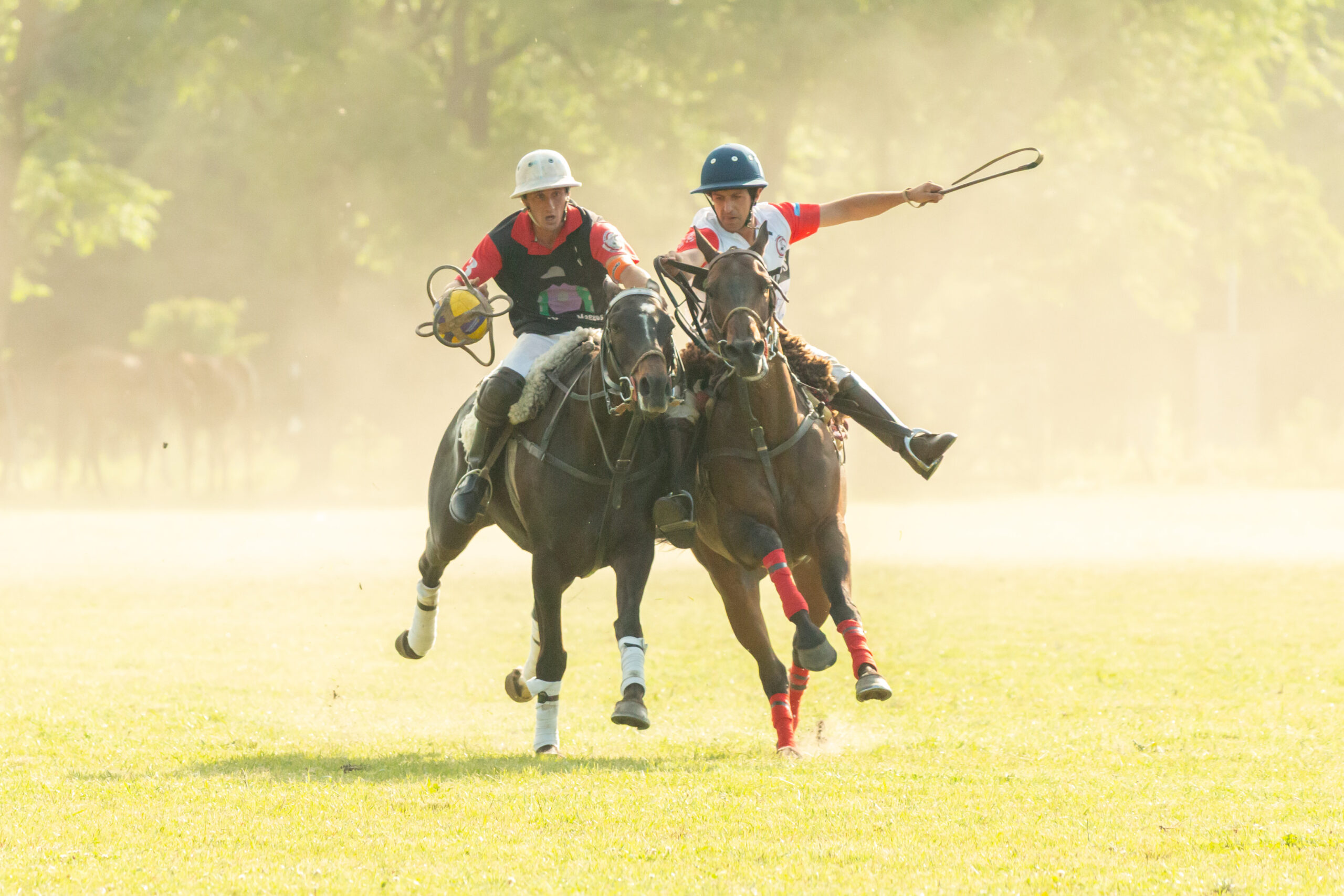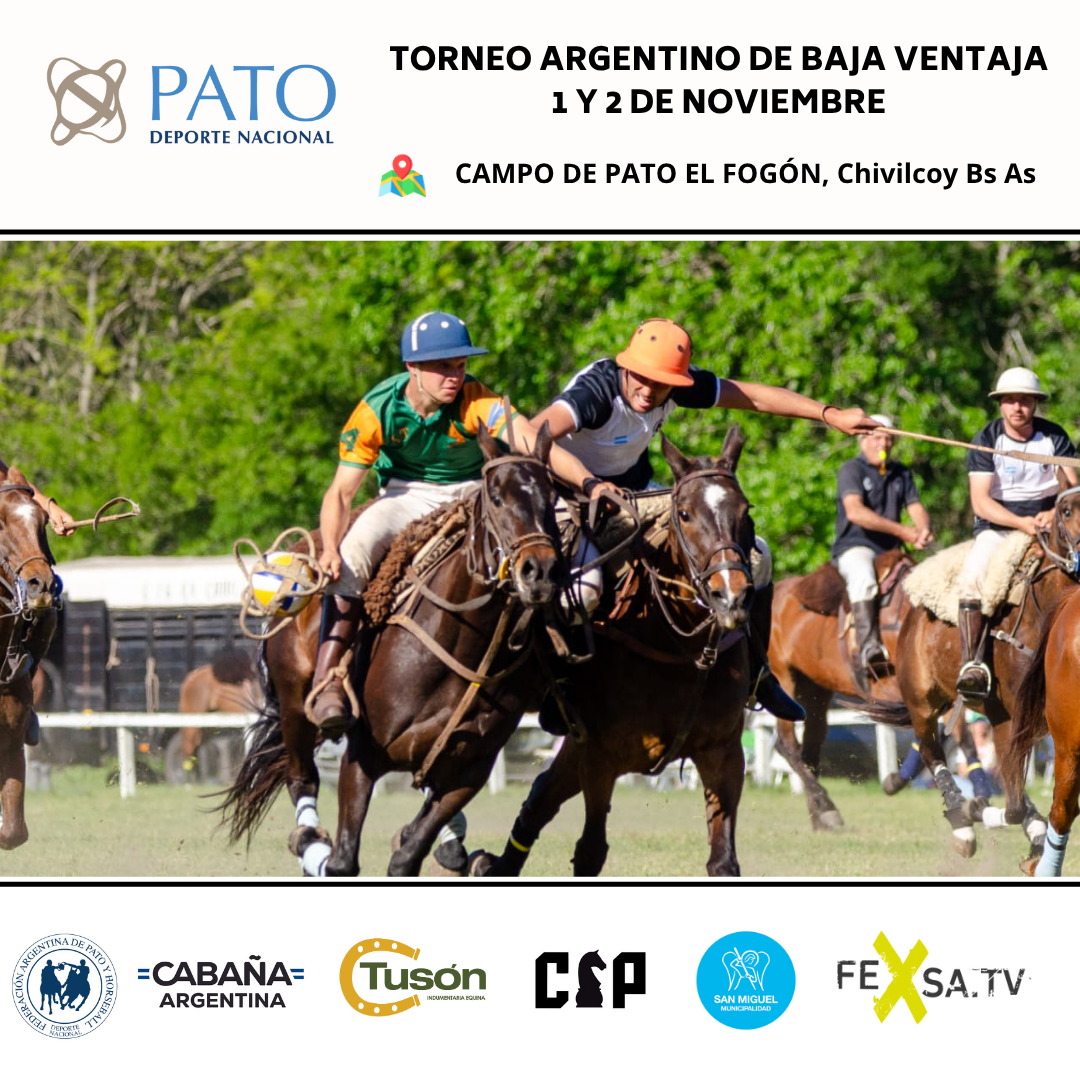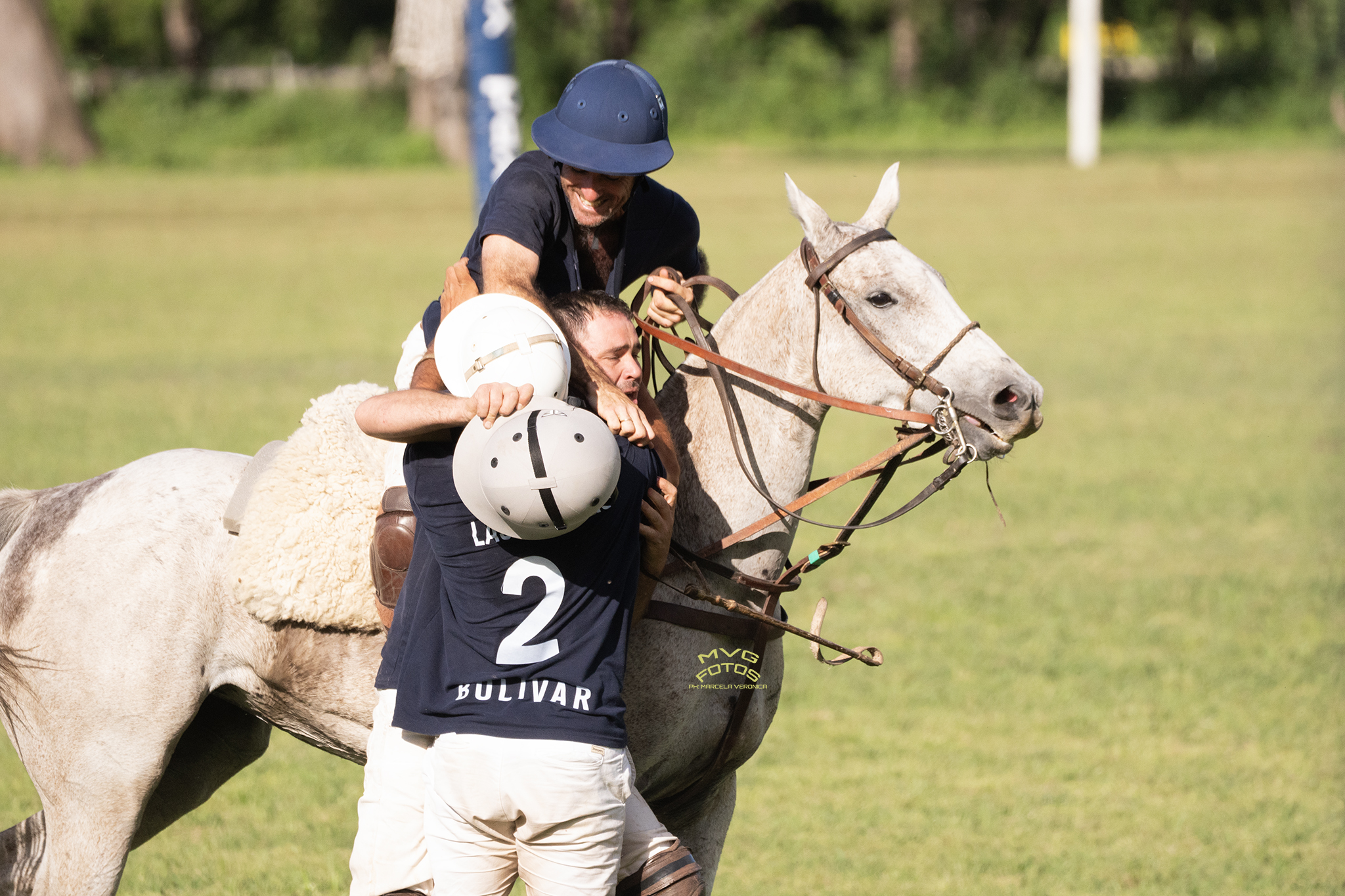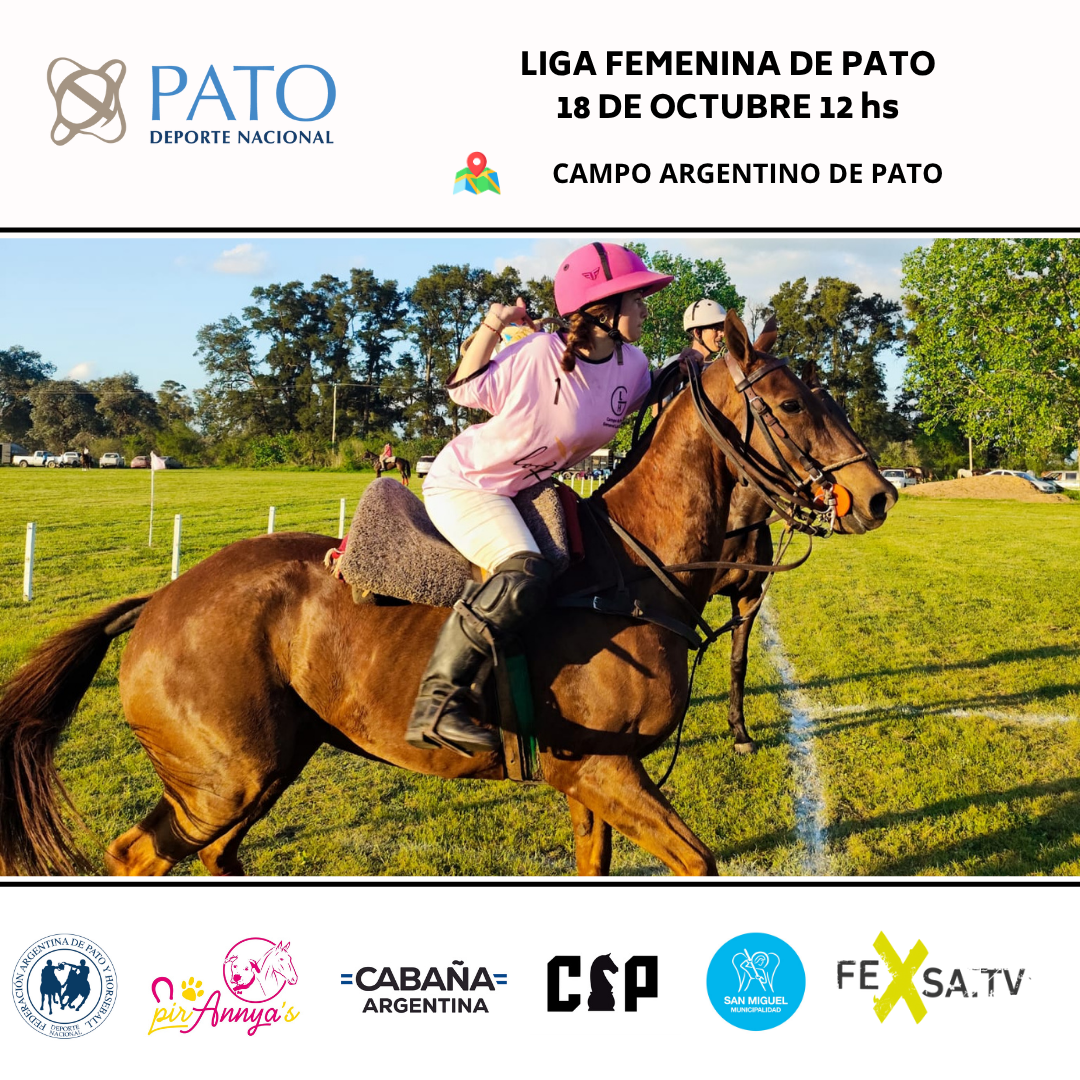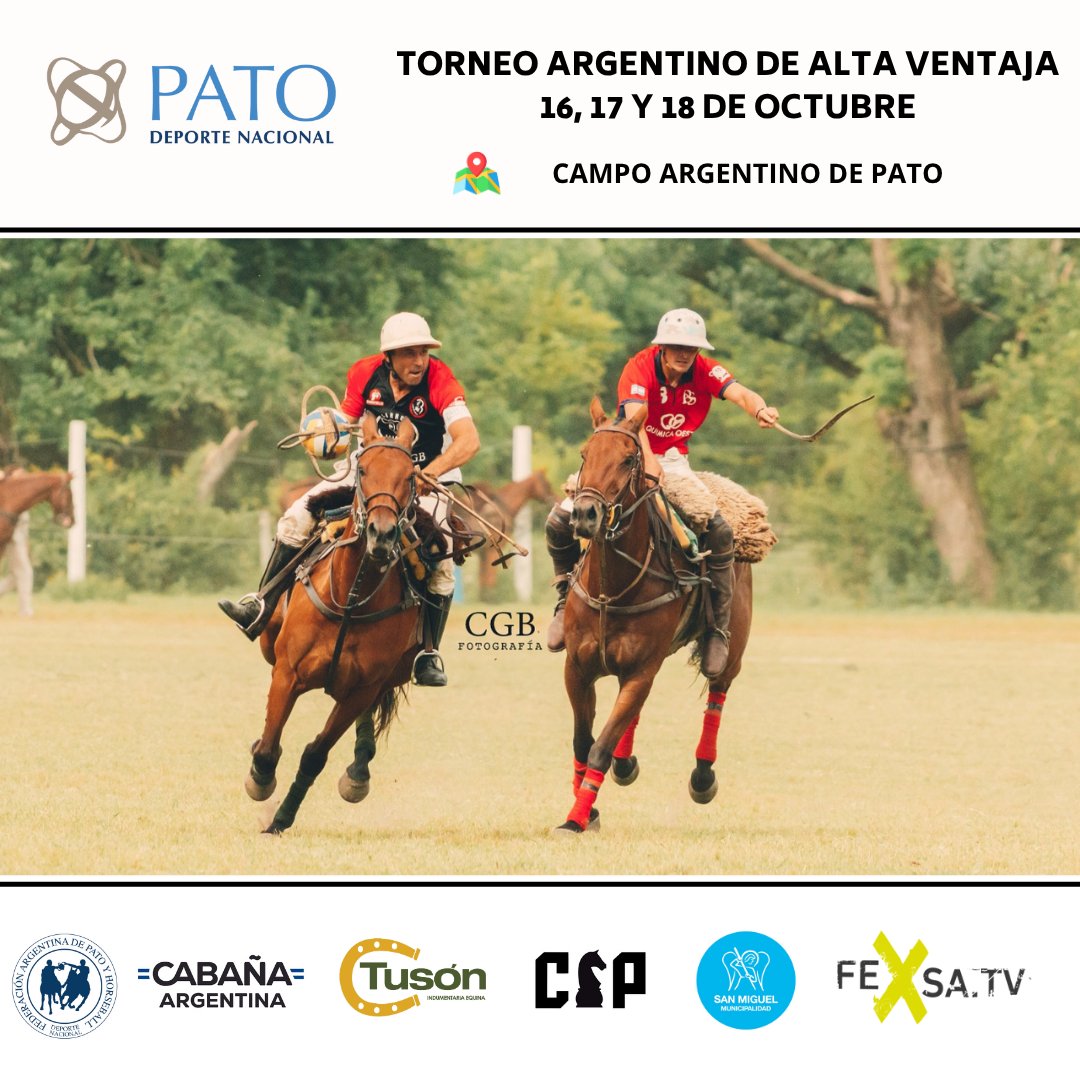Historia en Español
Deporte para gente de a caballo, audaz y valiente, EL PATO se practica en Argentina desde principios del siglo XVII, tal como lo muestra una crónica de Félix De Azar en la que relata una «corrida» realizada en Buenos Aires en 1610 con motivos de las fiestas de beatificación de San Ignacio de Loyola. Dice el naturalista «… juntan para esto dos cuadrillas de hombres de a caballo y señalan dos sitios apartados como de una legua (cinco kilómetros aprox.), luego cosen un cuero en el que se ha introducido un pato que deja la cabeza afuera, teniendo el referido cuero do o más manijas o asas, de las que se toman los dos más fuertes de cada cuadrilla en la mitad de la distancia de los puntos asignados y metiendo espuelas tiran fuertemente hasta que el más poderoso se lleva EL PATO, cayendo su rival al suelo si no lo abandona; el vencedor echa a correr y los del bando contrario lo siguen y lo rodean hasta tomarlo de alguna de las manijas, tiran del mismo modo, quedando al fin vencedora la cuadrilla que llegó con EL PATO al punto señalado».
En distintos escritos del siglo XVIII también aparecen varias referencias a estas corridas que, por su peligrosidad y trágicos resultados dieron lugar a que, en primer término las autoridades religiosas y luego las civiles, trataran de ponerle fin en 1796; un auto eclesiástico dice que se excomulgará y excluirá del templo como miembros corrompidos a quienes participen en corridas de PATO y se negará sepultura eclesiástica a aquellos que mueran en el tan bárbaro juego del PATO; Guillermo Hudson, en su libro «El Ombú», tiene un capítulo titulado, «Las Invasiones Inglesas y el juego de PATO», donde hace referencia a la peligrosidad que lo caracterizaba.
En 1822 el gobernador de Buenos Aires, General Martín Rodríguez, en decreto refrendado por su ministro de gobierno, don Bernardino Rivadavia, prohíbe en forma absoluta el juego del PATO, aunque no logre impedir su práctica.
Es don Juan Manuel de Rosas, quien durante su gobierno consigue suprimirlo, pero en 1852 se vuelve a tener conocimiento de que se está jugando nuevamente a través de una magnífica descripción hecha por el General José Ignacio Garmendia, en su libro «Cartera de un soldado».
En esta forma se llegó a 1937 cuando un cultor de nuestras tradiciones don Alberto de Castillo Posse, se dedicó a revivir el antiguo juego transformándolo en el deporte organizado para lo cual redactó el primer reglamento, creó la silla, ideó la pelota de 4 asas y luego de seis que se usa en la actualidad. En 1938, el gobernador de Buenos Aires, don Manuel A. Fresco derogó la prohibición comenzando una nueva etapa.
Es así como en 1941, se funda la Federación Argentina de Pato; asociación integrada por los campos en que se practica este deporte y que tiene por finalidad fomentar, dirigir, y difundir el juego del Pato; organizar los torneos y velar por la aplicación de los reglamentos, a la vez que orientar y promover la crianza del tipo de caballo más apto para este propósito.
RECORTES PERIODÍSTICOS AÑO 1942
En el año 1953, en mérito y arraigo de sus tradiciones, se lo declaró Deporte Nacional, por decreto del Poder Ejecutivo Nacional.
Decreto N° 17.468
EL JUEGO DEL PATO, DECLARADO DEPORTE NACIONAL MEDIANTE EL SIGUIENTE DECRETO:
DECRETO N° 17.468 – Bs. As., 16 de Septiembre de 1953.
Es declarado Deporte Nacional el Juego Denominado «El Pato»
VISTO: El anhelo expresado por los aficionados al deporte denominado «EL PATO», por intermedio de la Confederación Argentina del Deporte, en el sentido que dicho juego sea decretado Deporte Nacional; y CONSIDERANDO: que el origen de esta noble justa, de acuerdo con las investigaciones realizadas por numerosos historiadores, es auténticamente Argentina, puesto que dicho deporte era ya practicado por nuestros gauchos en los albores de la nacionalidad, y el mismo lleva puesto e impreso el sello de reciedumbre de jinetes diestros como eran y son los jinetes de nuestros campos; que su práctica desde entonces ha sido ampliamente superada desarrollándose actualmente en forma reglamentada; obteniendo el reconocimiento correspondiente como una actividad deportiva organizada y alcanzando amplia difusión y apoyo popular; que tales circunstancias son factor determinante para establecer sin lugar a dudas que al deporte «EL PATO» con exclusión de cualquier otro debe declárarselo «DEPORTE NACIONAL»; que es deber del Estado velar por que las nobles costumbres de raíz histórica pura como lo es «EL PATO», sean amparadas y apoyadas oficialmente, exaltando el sentimiento de nacionalidad y amor sobre lo realmente autóctono. Por ello:
El Presidente de la Nación Argentina, Decreta:
Artículo 1°, Declararse Nacional el deporte denominado PATO
Artículo 2°, El presente decreto será refrendado por el Señor Ministro Secretario de Estado en el Departamento de Educación
Artículo 3°, Comuníquese, anótese, publíquese desde a la Dirección General de Registro Nacional y archívese
JUAN D. PERÓN – Armando Méndez San Martín
Buenos Aires, Viernes 25 de Septiembre de 1953, Boletín Oficial de la República Argentina Numero 17.490
A brief history
In various writings of the eighteenth century appear several references to these runs that, for its danger and tragic results led in first place to religious civil authorities and then to civil ones, trying to put an end in 1796; an ecclesiastical says that will excommunicated corrupt temple members who participate in runs of “PATO([i])” and that ecclesiastical burial will be denied to those who die in the so barbarous game “PATO”; Guillermo Hudson, in his book ‘Ombu’ has a chapter entitled, ‘The Old English Invasions and the game “PATO” in which refers to the danger that characterized it.
In 1822 Buenos Aires Governor, General Martín Rodríguez, in a decree endorsed by his Government Minister, Don Bernardino Rivadavia, the game “PATO” was banned, but fails to prevent the practice.
Is Don Juan Manuel de Rosas, who during his government gets suppress it, but in 1852 it is said that is being played back through a magnificent description in the book ‘A soldier´s portfolio’ by General José Ignacio Garmendia.
It kept this way until 1937, when a worshipper of our traditions Don Alberto Castillo Posse, was dedicated to reviving the old game transforming it into an organized sport for which he drafted the first rule, created the chair, and devised the ball of 4 handles, then, one of six handles which nowadays has been still used. In 1938, Buenos Aires Governor, Manuel A. Fresco, repealed the ban starting a new phase.
Thus in 1941, the “Federación Argentina de Pato (F.A.P)” is founded; this association is composed of the areas where the sport is practiced and which aims are to promote, manage, and diffuse the game “Pato”; organize tournaments and ensure the implementation of regulations, as well as guide and promote the breeding type of horse more suitable for this purpose.
In 1953, in recognition of their traditions and roots, it was declared National Sport, by decree of the Executive.
“PATO”, DECLARED NATIONAL SPORT BY THE FOLLOWING ORDER:
DECREE Nr. 17,468 – Buenos Aires, September 16, 1953
It is declared National Sport the Game called “El PATO”
WHEREAS: The desire expressed by the sport fans called «EL PATO», through the Confederation Argentina of Sports, in the sense that this game is declared National Sport; and WHEREAS: the origin of this fair noble, according to research conducted by many historians, is authentically Argentina, since the sport was already practiced by our gauchos at the dawn of nationality, which wears and has printed the robustness seal of the skilled riders as they were and nowadays are the riders of our fields; since then its practice has been largely superseded being currently developed as regulated; obtaining the corresponding recognition as an organized sport and achieving wide spread and popular support; such circumstances are crucial to establish without any doubt that the sport «PATO» excluding any other factor must be declared ‘NATIONAL SPORT’; that it is a duty of the State to ensure that noble traditions of pure historical roots as it is «PATO», were officially supported and covered, highlighting the sense of nationality and love on what is truly indigenous. Therefore:
The President of Argentina, decrees:
1st Article, Declaring National the sport called “PATO”
2nd Article, This decree shall be endorsed by Secretary Minister of State at the Education Department
3rd Article, Communicate, sign up, published from the National Registration Department and filed
JUAN D. PERÓN – Armando Méndez San Martín
Buenos Aires, Friday September 25, 1953, Official Gazette of the Argentine Republic Number 17,490
F.A.P. Presidents:
- Mr. Alberto del Castillo Posse 1941/1942
- Mr. Manuel Andrada 1942/1945
- Dr. Eduardo Ortíz 1945/1946
- Col. Paz R. Alberto 1946/1948
- Col. Julio Moreno 1948/1949
- Col. Paz R. Alberto 1949/1953
- Cte. Samuel M. Zamora 1953/1955
- Mr. Raúl Alberto Píccoli 1955/1956
- Col. Paz R. Alberto 1956/1957
- Mr. José R. Sánchez Sañudo 1957/1959
- Mr. Guillermo Micheo 1959/1961
- Mr. Rogelio Cambiasso 1961/1963
- Esc. Julio Ricardo Moreno 1963/1965
- Mr. Raúl Alberto Píccoli 1965/1968
- Dr. Carlos Fausto Portela 1968/1971
- Esc. Julio Ricardo Moreno 1971/1973
- Mr. Jorge Celestino Garros 1973/1977
- Dr. Rodolfo Julio Ortiz 1977/1984
- Mr. Rubén Dario Gagliardi 1984/1996
- Mr. Jorge Pini 1996/1999
- Dr. Rodolfo Julio Ortiz 1999/2001
- Mr. Daniel Gabrielli 2001/2007
- Mr. Ricardo José Fernández 2007/2013
- Mr. Patricio Ezequiel Jaccoud 2013/2015
- Mr. Gustavo Adrián Lezaun 2015/2019
- Mr. Guillermo Eduardo Bracuto Faré (in activity)
[i] Pato: it is the Argentine National Sport. It was formerly played with a live duck hence derives its name.
Sport and Organization
Manly sport for horsemen, bold and brave, «El Pato([i])» is practiced in Argentina since the beginning of the seventeenth century, as shown in Felix de Azara´s chronicles in which he recounts that in 1610 there was a ‘run’ in Buenos Aires (30 years after the Second Foundation of Buenos Aires by Juan de Garay) owing to the celebrations for the beatification of San Ignacio de Loyola. The naturist says ‘Gather to two bands of horsemen and two sites apart as one league (approximately five kilometers) are indicated, then they sew a hide which has inserted a live duck sticking its head out, this hide has two or more handles, from which are taken the two strongest of each group they are midway of the assigned points and, spurring on their horse, they pull strongly until the most powerful carries out the duck, as a consequence the opponent falls to the ground if he does not leave before. The winning runs off and the opponents follow him until they could around him and could take one of the handles, they pull the same way, being the victorious group who finally get the duck to the marked point.’
On June 16, 1610 the Jesuit Diego de Torres Bello S.J. wrote a first letter to his superiors, telling that in every city of the Rio de la Plata, was held with religious, social and cultural events the beatification of the founder of the Society of Jesus, St. Ignacio de Loyola. And that in Buenos Aires (Bs. As.), ‘the artillery and musketry did their jobs, and some left with delighted intentions to run ducks in front of our church.’ ‘Two groups of riders raced ducks in front of our church (it was in the middle of what is now the Plaza de Mayo).’ Everyone was full of admiration for seeing them and the horses which seemed tireless running with so much discomfort.
On April 4, 1611, the second letter was sent. It calls a lot of attention that the participants were two Indian tribes and indeed that Spanish people, quite logically, did not provide them with horses and did not allow them mount because horses were one of their main weapons of conquest and war. However, states that ‘parents from Córdoba stimulated Indians from the Calchaquí valley with prizes in order that they could throw arrows to the ring and run ducks.’ The locals´ calchaquíes, beat the visitors Huachipas. It does not refer the game and its development. Its reading suggests that they firing live ducks chased through Bs. As. Streets and the valleys. (There are copies of the letters in “Del Salvador” school.)
Neither the brave Spanish people introduced this sport, nor Indians practiced it. The first is obvious, since it was an unknown sport at those times and even now in Spain, and it did not come from the naturals, because they did not know the horse, which was imported by the Spanish in the first half of the sixteenth century. It would seem that this is a Creole game, developed and planned by the conquerors themselves, or their immediate descendants.
Don Pedro de Mendoza was the one who introduced the horse in these lands in 1536, although their offspring (herds) were products of the few (about five mares speak seven stallions) that Don Irala abandoned when he left Buenos Aires in 1541. They were increased to infinity along with those who brought the amazing Cabeza de Vaca (now in these parts of the South) on his way from the coast of Brazil to Paraguay. And in 1542, with those which were brought by Diego de Rojas and in 1550 by Nuñez del Prado, during their incursions to the north of our country.
Around 1581, Juan de Garay, estimated roaming wild horses at 80,000 animals in a perimeter of 30 leagues from Buenos Aires. Fourteen years later, 1595, when the king asked Rio de la Plata Governor, Valdés de la Banda, a report on the horses that lived “La Pampa” he answers: ‘I say that Don Pedro Mendoza that was the first resident of this city and harbor, brought here horses and mares that were left in the campaign of this land that is very wide and long and over 80 leagues such a single stone is not found, having more than 100 leagues around so much of mares and horses that they seem to be mountains when they are viewed from afar and they are so many in number that exceed the great number that the historians say that had in the farms of the Media province from which the kings of Persia were served …’ Well, well, a bit exaggerated, no doubt. But this is the origin of their millions of descendants and promoters of the great revolution of the way of living of all indigenous inhabitants and those who followed them. And where have been horses exist these games, these skills, these equine sports.
A more detailed description is that of Amadeo Frezier (French, 1682-1773), a military engineer specializing in fortifications, who for more than two years sailed ‘South Sea’. It was in 1712 and he writes in his book, published in 1716: «I witnessed a party that was given by the agents of two Spanish named “Pedro”. It was the saint day of their masters in a village of Talcahuano, near which we were anchored. After hearing mass they rode to run the hen, as the goose is run in France, with some differences: that all threw on the one who has earned her head so as to take it off and bring before the one that they are making the party in honor, running at full gallop they were confronted to take it off and on their way they picked up from the ground everything that felled by land. After this race they dismounted for lunch.»
The Argentine novelist Guillermo Enrique Hudson (1841 – 1922) in his widespread book ‘The Ombu’ states that «El Pato” was the most popular outdoor entertainment practiced in Argentina.
Over the years, «El Pato» was practiced and also forbidden by religious and civil authorities for the high level of risk and the fatal consequences that brought with it the fact of wanting to reach with the duck at any price.
The first game ban that has been reported is on February 23, 1739, when it was ordered in Santiago del Estero with the following: ‘it is an excess and an outrage to play “pato” in the middle of town.’
Reverend Salbaire , who wrote the ‘History of Our Lady of Luján’ recorded a document in 1796, from the major Sacristan of the Parish, Gabriel José Maqueda , who admonishes and orders the parishioners to refrain from playing Pato, ‘combining it with the excommunication’ if they failure to do so.
But its real ban was in a decree of June 21, 1822 by Buenos Aires Governor D. Martín Rodríguez, endorsed by Foreign Affairs and Government Secretary Minister, D. Bernardino Rivadavia and that stated: ‘Anyone who is in this game, for the first time will be allocated for public works for a month, for two months in the second and six months in the third.’ ‘Furthermore, they will be subject to compensation for the damage caused.’ The police, mayors and judges of campaign were responsible for enforcing the ban.
It is said that Rosas ratified, but it seems that just simply enforce it in his strictly way. Then there was the referred police ordinance.
But in the era of Juan Manuel de Rosas “Pato” was almost nonexistent. Mitre wrote ‘his Odes’ during the siege of Montevideo, when he was between 18 and 20 years and released it at the age of 33, in 1854. In his composition called «El Pato» he says in a note: ‘The game “Pato” no longer exists in our customs, it is already a distant reminiscence. Severely forbidden by personal misfortunes that gave reason, people have left it slowly, without forgetting it entirely.’
Despite the ban some characters of the time stood out its qualities because it requires strong and vigorous men, able to tolerate the most terrible shores and the most extreme muscle tension. Mitre indicated in one of his rhymes:
“Pato”! Strong game
of the man from “La Pampa”
that marks customs
of manly people!
To spur nerves
to build muscles
as the young convulsive
in feverish pain.
Definitely «El Pato» was the most popular entertainment practiced outdoors in Argentina Republic.
Referring to an account of the game and the rude men or farmers, the writer José de Espinoza, tells us that for playing a game of “Pato” a gang of these rude men meet, all of them are excellent riders, one of them carries a leather with rings and his arm raise, he leaves as a ray having 150 rods, an with a sign, he and the rest run at the breakneck, forming he screams as the Moors: all chase the “Pato” and struggling to take the prey, the developments that he makes so as they do not achieve it are really skillful, now being a straight race and returning to the left, and breaking through those that follow, until one or more clever or happier, strips him of “el pato”, for what it is not permissible to take his arm. Currently all cheer and take him into applause, screams and samba to his ranch or the haunting, or to the lady who courts. Yet among these people, many remnants of the old Spanish gallantry reign.
In Pampa Argentina, Roberto Torreiro has written ‘while in the twentieth century no one remembered the former existence of the game “Pato”, on April 16, 1937, at the initiative of then chief security guard of the city of La Plata Don Alberto del Castillo Posse, supported in his action by a qualified group of athletes, carried out an exhibition of that sport, which term and because of the aroused enthusiasm among those present, it was decided to sponsor the practice spread of “Pato”, tending to build teams within the related entities with equine sports, and encouraging the establishment of institutions that originally engaged the practice of this sport. This initial step, constituted the first success of our national games.’
Alberto Castillo Posse , ruled the sport (a leather ball was used with four handles), whose work officially ended when after the essays produced on March 31, 1938, Buenos Aires Government Minister, Don Roberto Noble asked for repealing the regulation Nr. 1043 of Buenos Aires police (1889) which prohibited the practice of this game. Then the governor, Manuel Fresco agreed and carried out a decree on April 28, 1938 and says his legal reason: ‘Today sports are subject to disciplines imposed by its regulations and this game, in the way that is practiced today, is a healthy and vigorous sport similar to polo.’
What does it mean, subject to disciplines and regulations? Precisely, what is expressed literally: before 1937 there was no regulation, even though there was basis. Everything was valid, as valid, barbarian messy, brutal and dangerous that should be banned more than once until before mid-century that finally it was almost to oblivion, to be just a memory of traditions passed from mouth to mouth in the bonfire among the peasants.
On August 23, 1938, the newspaper “La Nación” commented on the first public display of “Pato”, held the previous day in the field of Ameghino Association, near the bridge “Cabildante Léxica”, in Luján city. The Buenos Aires Governor, Manuel Fresco attended President of National Deputies´ Chamber, Juan G. Kaiser and the Province Minister of Public Works, José María Bustillo, and many other special guests.
In 1941 the “Federation of Argentina Pato (F.A.P.)” is created. This association is composed by the areas where the sport is practiced and which aims are to promote, manage, and diffuse the game «Pato», organize tournaments and ensure the implementation of regulations, as well as guide and promote the breeding type of horse more suitable for this purpose.
In August 1943, a police commissioner – Sigfrido J. Imaz – became into «General Las Heras». To whom the “pateros ([ii])” of those times and nowadays owe him a deep memory. Riding a red horse and bringing a football with handles attached with leather thong to the saddle, while people tried to decipher what it was. Imaz, making a display on the beach at the train station, knocked it down and lifting it started to enthuse everyone until he achieves his goal.
On November 28, 1943, with Presidency of the police commissioner Mr. Imaz, the organization called “Campo de Pato General Las Heras” was founded, which purpose ‘were, are and will be to promote the Creole game “Pato” and cultivate traditionalists feelings of our country.’
In 1944, the «Campo de Pato General Las Heras», joins the “Federation Argentina de Pato” and being the first teams from “Las Heras”: «General Las Heras A» and «General Las Heras B».
On September 16, 1953, in recognition of their traditions and roots, it was declared ‘National Sport’ (Decree Nr. 17,468 signed by the National President, General Juan Domingo Perón). And late last century, General Las Heras is appointed as ‘Capital of Pato’, the sport most Creole of all-time.
Current game:
Hard and fast, this game requires to those who practice it a high degree of sport culture and strict compliance with their rules, it is played by teams of four players each, that between passes and combinations to evade the action of its opponents, try to introduce «El Pato» through a hoop of one meter in diameter located perpendicularly on a post of 2.40 meters high, located in the center of each of the two heads of the court, which measures between 180 and 220 meters long and between 80 and 90 meters wide.
“El Pato» is a leather ball with rubber bladder surrounded by three strings of rawhide cross transversely, in each of which two handles are sewn or symmetrically placed handles. It is mandatory for the player who has «El Pato» offer it to the opponents with his right arm extended perpendicular to his body. Any movement the player makes to prevent that the opponent takes one of the handles is a ‘denied’ act that is prohibited and punished by the rules, unless his intentions were finally to make a pass or to try to make a point. If an opponent manages to take «El Pato» originates a ‘cinching’, which has to be made without any support of the two riders chair or his own mount, i.e., ‘pure rein’.
The Federation has the «Campo Argentino de Pato» in “Campo de Mayo”, 30 km. from Capital Federal, on National Highway Nr. 8, wherein important tournaments of low, medium and high advantage which culminating in the Argentine Open Championship, maximum event of this sport that takes place in the «Campo Argentino de Polo» performed in Palermo, a magnificent scenery known as the best in the world.
“El Campo Argentino de Pato” has an area of 20 hectares and has two regulation fields – one with grandstand roof – fitted with sprinkler system and located amidst ancient trees. It has enough complementary facilities to hold simultaneously about 100 horses, with their pens, their bathing areas, platforms, fences, etc., in order to call the attention of players and audience.
‘We must forget the folkloric aspect of the “Pato”. We do not have to repudiate its “gauchos” rural origins, fully Argentine. But you do not need to dress in such way to play it. Today it is a sport like others. To play polo is not necessary to wear Mandarin clothing if it has China´s origin, or like an Indian rajah, if it was born there. Needless to dress as a “gaucho” to play “Pato»’ says Rubén Liborio Cosentino, he has played “Pato” since he was 16 years old.
[1] Pato: it is the Argentine National Sport. It was formerly played with a live duck hence derives its name.
[2] Pateros: people who play Pato.
